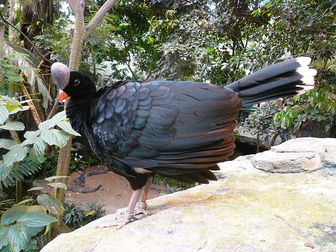Helmeted Curassow
The Northern Helmeted Curassow, Pauxi pauxi is a large terrestrial black curassow with a small head, large bluish grey casque on forehead, red bill, white-tipped tail feathers, greenish glossed mantle and breast feathers, and white below. Both sexes are similar. The male, at 3.6 kg , is larger than the female, at 2.6 kg . Some rare rufous morph female has a black barred and reddish brown plumage. For some time, it also contained the Southern Helmeted Curassow taxa as subspecies and was simply known as the Helmeted Curassow. Nowadays its southern congener is considered a distinct species P. unicornis.

Original source: http://www.flickr.com/photos/radunzel/3582991078/
Author: http://www.flickr.com/photos/radunzel/
The Helmeted Curassow is classified as Endangered (EN), considered to be facing a very high risk of extinction in the wild.
The Northern Helmeted Curassow, Pauxi pauxi is a large (up to 91 cm long) terrestrial black curassow with a small head, large bluish grey casque on forehead, red bill, white-tipped tail feathers, greenish glossed mantle and breast feathers, and white below. Both sexes are similar. The male, at 3.6 kg (8 lbs), is larger than the female, at 2.6 kg (5.8 lbs). Some rare rufous morph female has a black barred and reddish brown plumage. More
* Southern Helmeted Curassow or Horned Curassow, Pauxi unicornis * Genus Crax * Great Curassow, Crax rubra * Blue-billed Curassow, Crax alberti * Yellow-knobbed Curassow, Crax daubentoni * Wattled Curassow, Crax globulosa * Red-billed Curassow Crax blumenbachii * Bare-faced Curassow, Crax fasciolata More
Helmeted curassows are characterized by a bony outgrowth on the forehead. This species has a unique ornamentation, a large globose bluish grey knob above the bill. Length is 33.5–36 in (85–92 cm). Males weigh 7.7–8.3 lb (3.5–3.75 kg); females weigh 5.8 lb (2.65 kg). DISTRIBUTION This species is found in northern Venezuela and northeastern Colombia. HABITAT Found in dense, cool montane cloud forest above 1,650 ft (500 m). More
The Northern Helmeted Curassow's range includes the mountains of central and coastal Venezuela from central Miranda and southeastern Falcon west to the boundary with Columbia, as well as extreme northeastern Colombia. Thier habitat consists of rain or cloud forests in the subtropical zone and adjacent edges of the tropical and temperate zones. With their center of distribution at about 3200 to 4700 ft., Northern Helmeted curassows are more cold hardy than other curassows. More
The southern helmeted curassow is known from central Bolivia and central and east Peru. The nominate subspecies, C. u. unicornis, occurs in the adjacent Amboró and Carrasco National Parks, Bolivia. Only a single individual has been observed outside these protected areas in the last 30 years, in Cerros de Távara, Puno, Peru, in 1992 (2). The subspecies C. u. More
helmeted curassow (Pauxi pauxi), of the Venezuelan and Colombian mountains; and the critically endangered razor-billed curassow (C. mitu), of the Amazon. For more information on curassow, visit Britannica.com. Columbia Encyclopedia: curassow - Top Home > Library > Miscellaneous > Columbia Encyclopediacurassow (kyûr'əsō'), common name for the largest members of an order of game birds called pigeon-toed fowls, which includes the white-crested guan and the rufous-bellied chachalaca, Ortalis wagleri. More
The northern helmeted curassow is found on the eastern Andes of west Venezuela and neighbouring north-east Colombia (2) (6). View a distribution map for this species at UNEP World Conservation Monitoring Centre. Habitat - This species is confined to subtropical cloud-forest in steep, mountainous regions between 500 and 2,200 m (mostly 1,000 to 1,500 m) above sea level (2), where it favours humid gorges with plenty of undergrowth and avoids forest edges (2) (6). More
The Northern Helmeted Curassow (Pauxi pauxi), is a species of bird in the Cracidae family of chachalacas, guans, and curassows. It is found in the eastern Andes of Venezuela and Colombia. It is listed on Appendix II of CITES, and was formerly listed as Vulnerable on the IUCN Red List. Recent research has shown, however, that numbers of this species is decreasing more and more rapidly. It was upgraded to Endangered in 2008. More
The Northern Helmeted curassow has black, gray, and white feathers, a large body and a small head. Males are larger than females, but both are strong. Despite this strength, they are sometimes nervous and easily scared. When frightened, it will jump or fly straight up in an attempt to flee. The Northern Helmeted Curassow eats mostly fruits, leaves and berries. However, it will also eat insects, small rodents, and reptiles. More

Original source: Emijrpbot
Author: Emijrpbot
Permission: Some rights reserved

